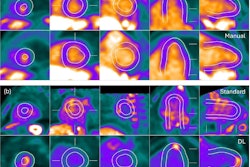PET/CT imaging with iodine-124 (I-124) evuzamitide may help monitor how patients with cardiac amyloidosis respond to therapy over time, according to a study presented at the American Society of Nuclear Cardiology annual meeting in Austin, TX.
Emily Martin, PhD, of the University of Tennessee Medical Center in Knoxville, discussed her group’s latest research on the investigational approach, with repeat scans more than two years after baseline showing changes in cardiac and extracardiac amyloid load associated with the disease.
“Cardiac uptake of I-124 evuzamitide in patients correlated with echocardiographic parameters of structure and function and serum NT-proBNP,” Martin noted in a September 5 session.
Amyloidosis develops when, for reasons that remain unclear, amyloid proteins misfold and build up in the body’s organs. There are two main types, transthyretin amyloidosis (ATTR) and light-chain amyloidosis (AL). When the disease occurs in the myocardium, the amyloid build-up restricts cardiac function and can lead to heart failure and death, the authors explained.
Currently, there are no specific imaging agents for semiquantitatively monitoring this so-called “cardiac amyloid load,” according to the researchers.
Recently, however, I-124 evuzamitide received breakthrough therapy designation from the U.S. Food and Drug Administration, with studies showing that the tracer allows clinicians to discriminate between patients with the disease and healthy subjects. In addition, a variant of the imaging agent is also under development for use in SPECT/CT imaging.
In this study, the investigators further evaluated the utility of the tracer. Between July 2022 and December 2023, they enrolled 19 patients, nine with AL and 10 with ATTR amyloidosis who all showed positive cardiac uptake of I-124 evuzamitide in a previous baseline study.
Martin and colleagues quantified radiotracer uptake in the heart, liver, spleen, and kidney based on standard uptake value ratios (SUVR) using blood pool as the reference. Serum biomarkers were measured, and transthoracic echocardiograms were performed prior to imaging. Additionally, they compared radiotracer uptake with serum NT-proBNP and echocardiographic parameters, two established clinical methods for monitoring the disease.
 I-124 evuzamitide PET/CT images of a patient with light-chain amyloidosis showing a decrease in amyloid load and organ volume on follow-up.Image courtesy of the American Society of Nuclear Cardiology
I-124 evuzamitide PET/CT images of a patient with light-chain amyloidosis showing a decrease in amyloid load and organ volume on follow-up.Image courtesy of the American Society of Nuclear Cardiology
According to the analysis, the mean time between imaging was 2.9 years. An increase in cardiac uptake was observed in three patients with ATTR amyloidosis and in only one with AL amyloidosis. For the entire population, there was a significant correlation between the change in cardiac tracer uptake and change in serum NTproBNP (Spearman rank correlation coefficient [rs] = 0.62, p = 0.005).
In addition, significant correlations were observed between cardiac I-124 evuzamitide uptake and left ventricle wall thickness (Pearson correlation coefficient [rP] = 0.71, p = 0.0007), and global longitudinal strain (rP = 0.47, p = 0.043). The researchers observed decreases in hepatosplenic amyloid load and organ volume in two of the AL patients.
Ultimately, treatments for ATTR and AL have been developed that are specific to the amyloid type and thus, in addition to early diagnosis, identification of the amyloid type is critical for effective patient management, the team noted. Based on this and earlier studies, in these regards, I-124 evuzamitide shows promise, Martin suggested.
“PET/CT imaging of I-124 evuzamitide is a promising technique for monitoring response to therapy in patients,” she concluded.




















